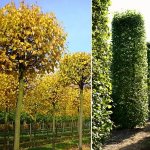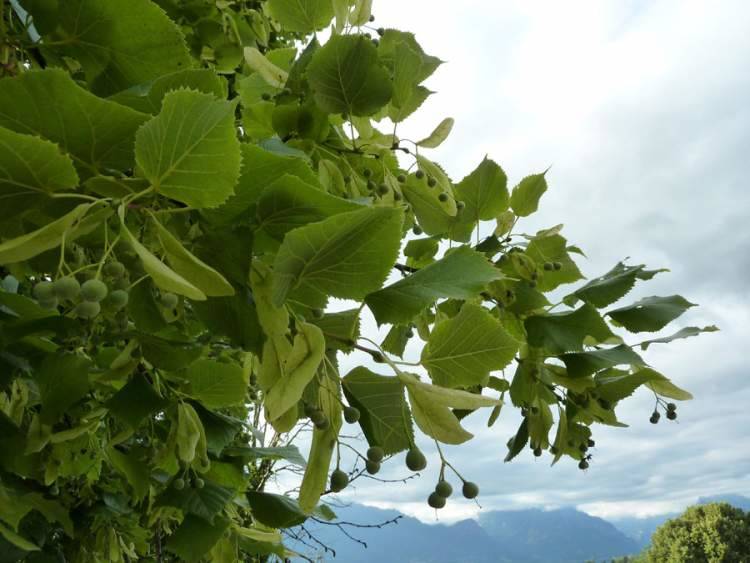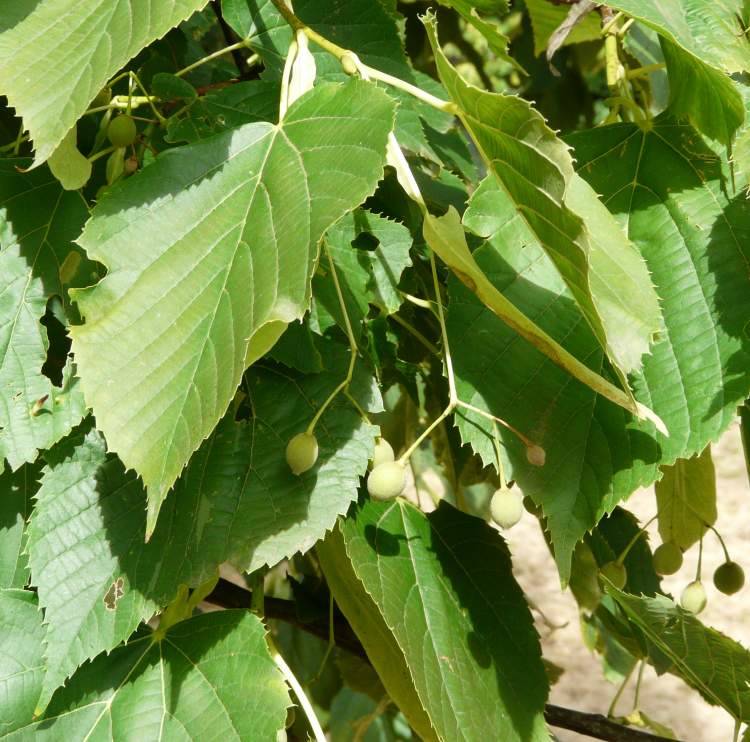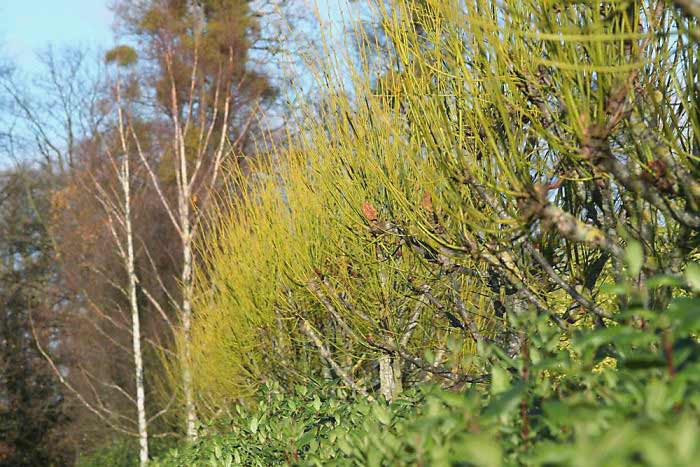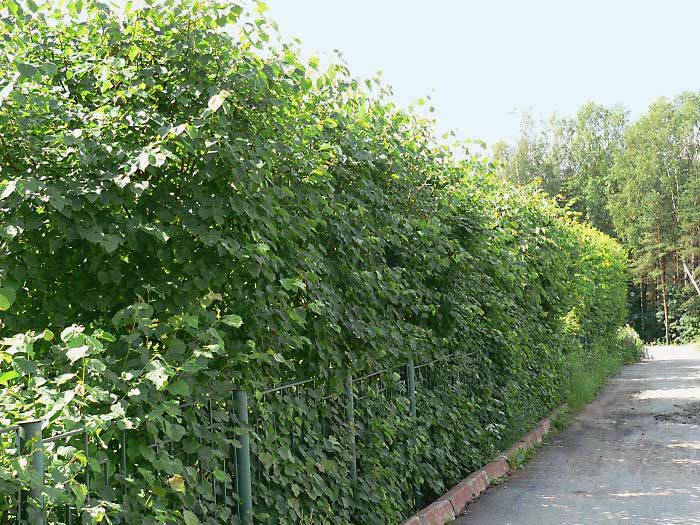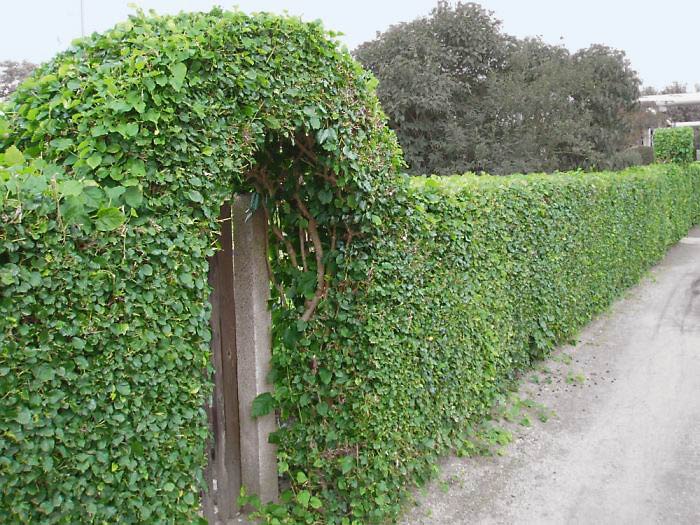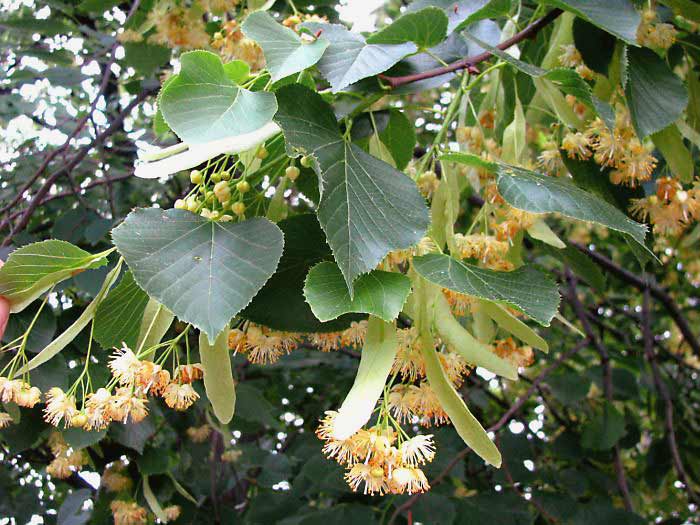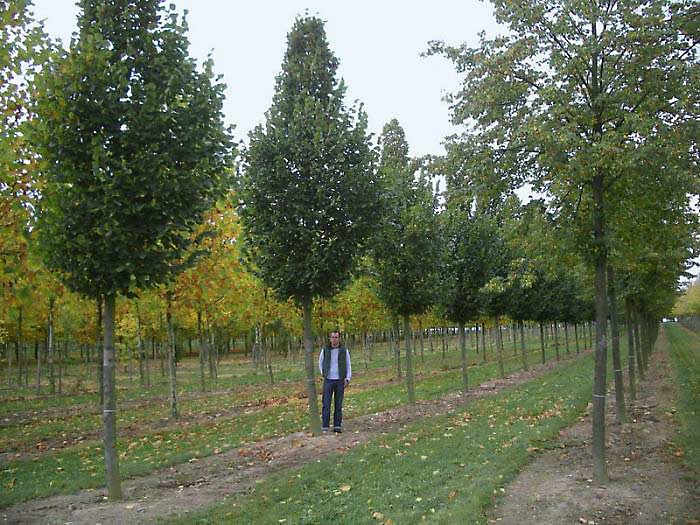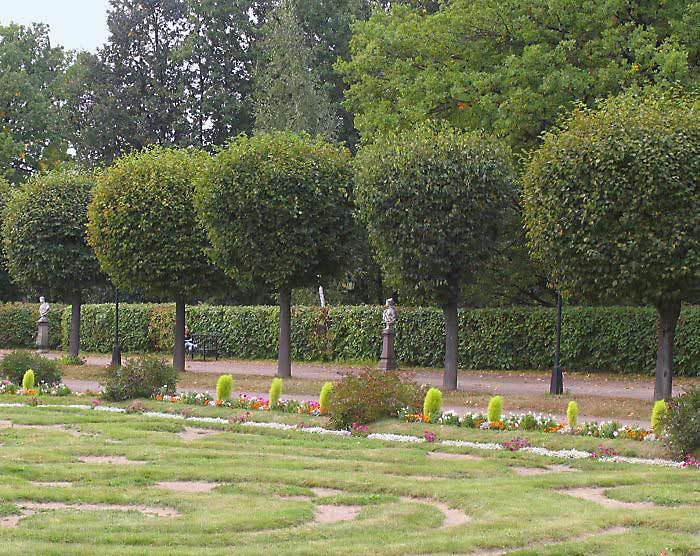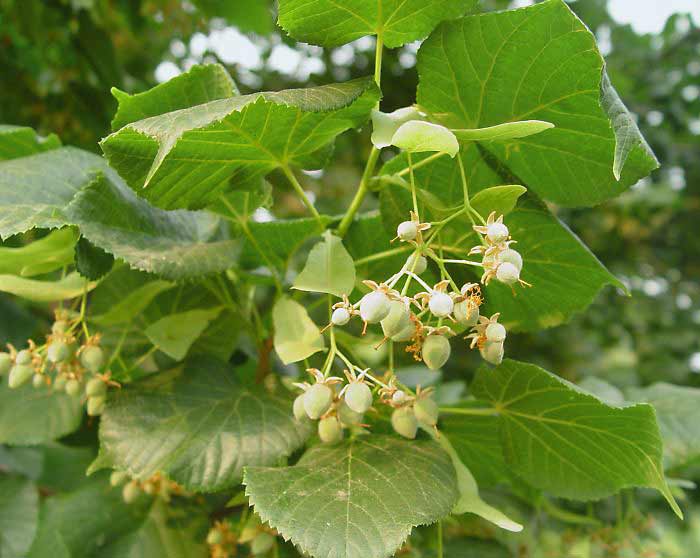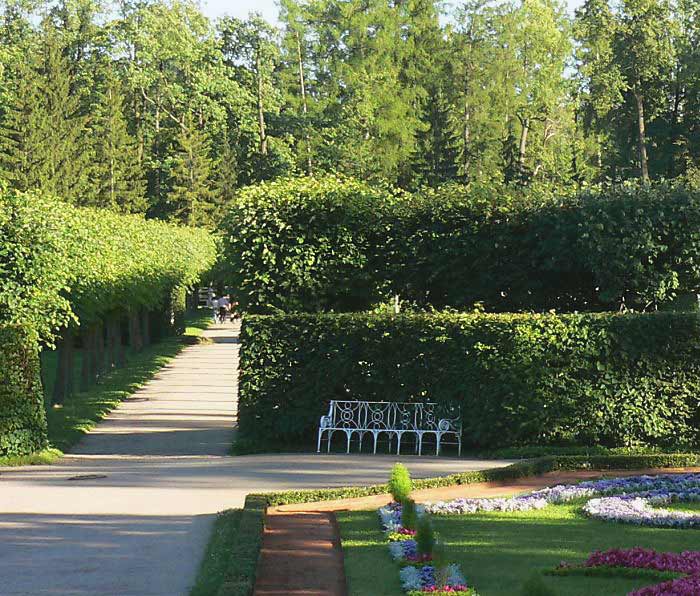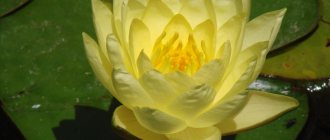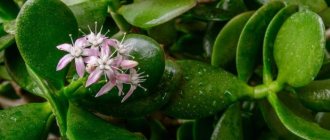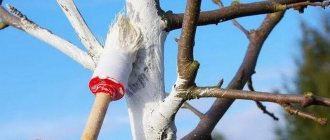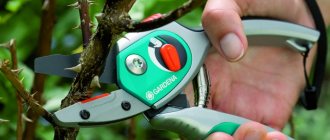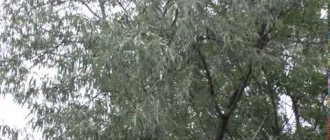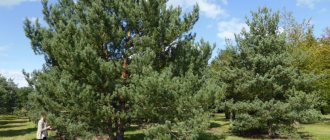If there is a garden, then it does not have to contain only pears and apple trees. Even for the most modest plot, you can find varieties of linden that will delight you with their shapes, attract bees, and provide medicinal raw materials. Of course, most often we see majestic linden trees with a wide spreading crown. But among them there are species that are quite suitable for a private garden, especially in the large-leaved linden. And if there is a place, it means that the European linden will be able to find a refuge in your country house. What are the most popular linden trees among amateur gardeners?
Description of the plant
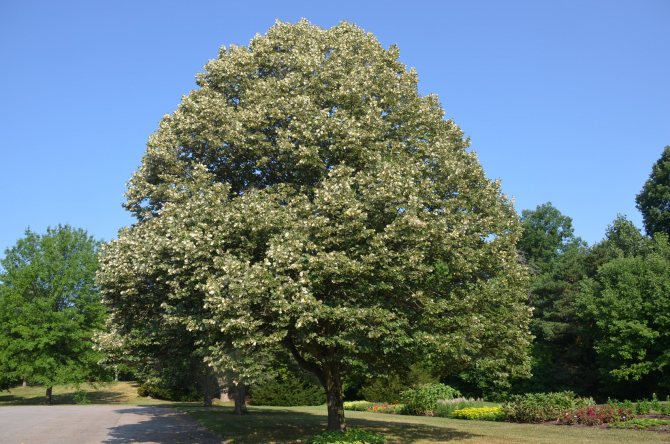
Lindens are large deciduous trees up to 40 meters high. It's nice to see what a linden tree looks like: a dense, beautiful, dense, easily molded crown, pleasing to the eye. Linden leaves are simple, alternate, shaped like a heart, with notches along the edge, pointed. In addition to a beautiful crown, linden has fragrant flowers, lemon shade, collected in corymbose inflorescences.
Linden blooms for two weeks in July. The tree blooms in natural conditions at the 20th year of life, and in plantations - only after 30 years. At the time of flowering linden, the air is filled with a light delicate honey aroma, which is felt far beyond the linden gardens and parks.
Linden fruits are single-seeded nuts. The seeds are tiny, the size of a pea. Fruits-nuts are collected in several on separate stalks. Each such stalk is equipped with a special winglet, thin and rather wide. This winglet helps the seeds fly over long distances. It is easy to remember what a linden tree looks like, it can always be distinguished from other trees. In summer, on heart-shaped leaves, in early spring on crimson young twigs with buds, silky bark. The root system of trees is strong and deep.
Plants can reach a respectable age, but to the question: "How many years does linden live?" There is no definite answer. Linden trees are known, which are up to 800 and even 1000 years old. In the forests where linden grows, other plants also thrive, since the falling linden foliage is a nutritious fertilizer. In addition, linden is a well-known melliferous plant. Linden honey is considered one of the best.
General information about the plant and the height of the linden tree.
Botanical name: European linden, or heart-shaped linden, or small-leaved linden, (Tilia cordata) - linden genus, Linden family.
Homeland of the heart-shaped linden: Europe.
Lighting: light-requiring, shade-tolerant.
Soil: drained, moist.
Watering: plentiful.
Maximum tree height: 30 m.
Average lifespan: 150 years, some individuals live up to 1200 years.
Planting: seeds.
Description of the linden tree cordate
Large deciduous tree up to 30m high. The crown is wide, tent-shaped. The trunk is straight, up to 2 - 5 m in diameter.
The bark is gray, fissured. Young shoots are light brown, pubescent, while older ones are dark, glabrous. Buds are oval, first densely pubescent, then glabrous, 4-5 mm long.
The leaves of the linden tree are heart-shaped, for which the plant got its name. Leaves are simple, alternate, rounded, elongated, serrate edge, pointed apex. Dark green above, hairy, light below, densely pubescent with bristly hairs, up to 17 cm long and 19 cm wide. They keep on thin petioles 3-5 cm long.Young leaves have stipules that fall off quickly.
The inflorescence consists of 3-8 flowers. The buds are spherical, 3 - 4 mm in diameter, slightly pubescent, yellowish, regular in shape. The inflorescence is located on the axis to which the pre-colored leaf is attached. The leaf grows together with the petiole, the inflorescence itself emerges from its middle, so the linden flowers are collected together with the pre-colored leaf.
When does linden blossom?
When linden blossoms, the air is filled with a strong, pleasant aroma. Flowering begins in June, lasts 10-15 days. It fades faster in hot, dry weather.
Fruits are round, elongated, small nuts, with a dense shell, sometimes with grooves, 7-10 mm long, 6-9 mm wide. There is a seed inside the fruit. Fruiting begins in August - September. The European linden is frost-resistant. Able to withstand frosts down to -40⁰С. In the photo of the heart-shaped linden, unusual, peculiar leaves are clearly visible, which are a distinctive feature of this tree.
The distribution of the plant is small-leaved linden
The linden plant grows in Europe and Southeast Asia. Found in central Russia. Lives in mixed, deciduous and coniferous-deciduous forests.
It grows in a mixture with other species, often side by side with oak. Numerous lime forests are found in the southern Cis-Urals. In Berlin, there is a long linden alley called Unter-den-Linden, which means “under the linden trees”.
Planting a linden tree
Small-leaved linden (heart-shaped) can grow equally well in illuminated areas and shady places. Prefers leached, drained, moderately moist, structured soils. Its own fallen leaves improve the properties of the soil.
Linden is grown from seeds. Under natural conditions, seeds, falling into the soil, are stored in it for about a year and germinate the next spring. For normal germination, linden seeds are stratified, cooled and soaked. To do this, they are placed in wet sand and stored in it for up to 5 months at a temperature of 0 ° C. For high germination, all stratification conditions must be observed. In the spring, the seeds are planted in moist soil and provided with abundant watering. Planting seeds in autumn does not require prior stratification, but germination in this case may be low.
Sowing with seeds can be replaced by transplanting linden seedlings, which often begin to grow near older individuals. Saplings are dug up in the forest or forest belt. They can be recognized by their lobed cotyledons. They easily tolerate transplanting, especially if it is done in wet weather. The site for planting seedlings must be fertilized with humus. Planting holes must be at least 60 cm deep. Humus or compost is poured at the bottom. A seedling placed in a hole is covered with earth and watered abundantly.
When planting in groups, it is necessary to leave a distance of 3-4 m between the plants. The root collar should be on its surface after subsidence of the soil. Sod, sand and humus are used as a soil mixture. A drainage layer of crushed stone, 20 cm high, is required. In early spring, additional feeding is made with mullein, urea and ammonium nitrate. The first week after planting requires abundant watering. During dry periods, young seedlings need frequent and abundant watering. Adults do not need watering.
Linden seedlings can be bought at the nursery. They can be large-sized, reaching up to 5 m in height or ordinary seedlings up to 2 m. The seedlings should be with a lump, while the root collar is located on the surface of the coma. When buying, you should check the roots of the seedling. They must be strong and healthy. Seedlings are chosen according to their appearance, with the correct crown and no traces of damage or disease.
Pests and diseases
Diseases: white rot, seed mold, leaf spot.
Pests: soldier bug, yellow-throated mouse, silver hole, unpaired silkworm, birch and winter moth, bark beetles, goldfish, woodcutter, leafworm, goldtail.
Characteristics of linden for use in medicine
The linden tree has been used in folk medicine since ancient times. The Slavs used the charcoal of the wood of this tree to heal wounds and heal the gastrointestinal tract. The slime of the boiled lime bark was used to treat burns. A decoction of fresh buds and leaves was used as an anti-inflammatory and pain reliever. Powder from dry crushed leaves was used for nosebleeds, lime nuts were used to stop internal bleeding. The infusion of linden flowers was an excellent diaphoretic, and was also used for colds, fainting. All parts of the plant were considered medicinal.
In modern scientific medicine, linden flowers and pre-flowers are used, they are used as a diaphoretic. Infusion of flowers is recommended for rinsing the mouth with inflammation of the gums, and throat with sore throat. Linden tea effectively treats colds, flu, sore throats, pneumonia.
Decoctions, infusions and teas are prepared from flowers. Linden blossom drink has a pleasant aroma and sweet taste. In addition, lotions and compresses are made from linden flowers. For nervous disorders and increased excitability, baths with the addition of linden broth are recommended. Such a bath not only calms the nervous system, but also has a beneficial effect on the entire body as a whole.
Lime infusion helps to reduce the oily skin of the face, which should be regularly wiped on the skin. Linden flower tea has a diuretic effect, treats urolithiasis, cystitis, pyelonephritis, hypertension.
Linden fruits are collected, crushed and used as a hemostatic agent for external and internal bleeding.
From linden bark tea is brewed, which has choleretic and diaphoretic properties, increases the protective functions of the body.
Linden charcoal is used for diarrhea, dysentery and other diseases of the stomach and intestines. It is obtained from wood and tree branches.
Linden tea has a number of contraindications. It gives additional stress to the heart, so it should be used with caution. When drinking linden tea, it should be remembered that this is primarily a medicinal drink, therefore, they cannot be substituted for ordinary teas.
Collection and procurement of raw materials and leaves of linden trees
Flowers are harvested during the flowering period, when a significant part of them has blossomed, and the rest is in the buds. The collection of raw materials continues for 10-14 days. Inflorescences damaged by diseases and pests are not subject to collection. Do not pick flowers that have not dried after rain or dew, as they will turn brown when dried. The collected inflorescences are dried in attics or in a well-ventilated area, spread out in an even layer of 4-5 cm on paper. It is not recommended to dry in the sun, this leads to a loss in the quality of raw materials. In warm, dry weather, the flowers dry out in 5 days. Drying stops when the stalks become brittle. The shelf life of raw materials is 2 years. Dried flowers have a faint, pleasant aroma. The taste is sweetish, astringent.
The buds are harvested in spring in dry weather. Dried in dryers or under a canopy. Shelf life is 2 years.
The bark is harvested in early spring before flowering or late autumn. It is dried, ground into powder and brewed like tea. Shelf life is 3 years.
The leaves are harvested fresh along with the buds. Dried under a canopy. Shelf life is 2 years.
Linden scent and linden honey
During flowering, the strong linden scent spreads over long distances. This smell attracts bees. Linden is an excellent honey plant, the honey of this plant is very useful, it is transparent and has a sweet taste.For colds, a complex treatment with honey and tea from this tree is recommended.
There are 17 million flowers per hectare of linden forest, from which up to 1.5 tons of nectar can be collected. One bee colony collects up to 5 kg of honey from a tree per day.
The use of linden in the old days
Having studied the pages of history, one can be convinced that one of the most widespread and important trades among the ancient Slavs was beekeeping. Honey and wax have been exported from Russia for many years. Linden honey in combs was used to treat colds. Skin diseases were treated with honey.
The peasants used linden for weaving shoes. Hence the saying: "feeds, linden shoes". Since bast shoes wore out quickly, one person needed up to 40 pairs of such braids a year. They also made matting, ropes, boxes, coolies from linden.
Quivers for arrows were woven from linden bast, and military shields were made.
Initially soft linden wood, when dry, becomes very hard. This property made it possible to use it in everyday life. Kitchen utensils, ladles, cups, jars, carts, sleighs, carved frames, souvenirs, toys were made from wood. Baths and barns were cut from linden. Linden barns were not damaged by rodents; baths made of this tree kept warm for a long time.
From time immemorial, it was customary to steam in a Russian bath with a linden broom. From the same tree, houses for ablution were erected, shelves and benches, washcloths and other bath accessories were made. In the Russian bathhouse there was traditionally a vat of linden kvass, buckets of linden honey. The vapers drank mead and linden tea during their rest.
Linden fruits and flowers in cosmetology
Linden color is used in cosmetology for skin and hair care. Due to its antiseptic, anti-inflammatory properties, it deeply cleanses the skin, eliminates inflammation, has a soothing effect, does not dry out or irritate the skin.
Steam baths are used to care for normal and oily skin. For dry skin, decoctions of linden blossom and linden fruits are used.
In addition, linden is a good hair care product. From it, you can prepare a natural rinse, which is used after each hair wash.
Application in construction
Linden lining looks unusual and very beautiful, it is durable, resistant to temperature changes, tolerates high air humidity, has a light weight, and is easy to install. Used for interior cladding of saunas and baths.
The wood of this tree is often used for the construction of baths. It lends itself well to processing, keeps warm for a long time and fills the bath with a pleasant aroma. It is an excellent material for interior decoration, as it does not burn.
The linden tree was considered sacred by the ancient Slavs. He was associated with the goddess of love - Lada, who personified happiness, beauty and grace.
Linden has a soft yet strong energy. It absorbs negative energy, relieves depression and depression, restores vitality. Contact with a tree creates a feeling of peace, warmth, inner harmony.
Linden was a favorite plant in country estates. Today, in different parts of Russia, on the site of ancient parks, there are centuries-old lime trees. For example, in the village of Mikhailovskoye, a whole linden alley has been preserved, where A. Kern loved to walk. The linden alley in Yasnaya Polyana, associated with the name of Leo Tolstoy, has also survived.
Description of European linden
European linden (Tilia europea) is an ornamental, deciduous tree with an oval crown, reaching up to 40 m in height. Grows in Western Europe. The crown diameter is 20 m. The upper branches are directed upwards, the middle ones are located horizontally, the lower ones hang down. The diameter of the trunk is 2 m. The leaves are heart-shaped, rounded, uneven, with a serrate edge, on a long petiole, dark green above, smooth, light below, up to 6 cm long. In autumn they acquire a yellow color.The flowers are small, yellowish-white, collected in inflorescences of 5-8 pieces, with a light green bracts. Flowering begins in June - July. Lasts 10-12 days. The fruits of the European linden are spherical small nuts without ribs.
Possesses high frost resistance. Shade-tolerant. Drought sensitive. It tolerates urban conditions well, absorbs dust. Not demanding on the soil. Prefers fertile, drained areas. Easily tolerates pruning and crown shaping.
Used to create parks, alleys, hedges. Tolerates transplantation well. Propagated by seeds, cuttings and layering. Lives up to 500 years. Often adjacent to oak and maple. It has a number of decorative forms, the most interesting of which is the European vine-leaved linden, characterized by large 2-3 - top, serrated leaves.
Characteristics of the common linden
Common linden (Tilia cordata Mill) is a natural hybrid of small-leaved and large-leaved linden. Has acquired the features of both parents. The height of the tree reaches up to 40 m in height. The crown is dense, wide-pyramidal.
Leaves are large, simple, alternate, heart-shaped, sharp-toothed, with an elongated tip, dark green, up to 8 cm long.The flowers are yellowish-white, small, up to 1 cm in diameter, fragrant, collected in corymbose inflorescences of 3-15 pieces, with filmy bracts.
Fruits are small spherical nuts up to 8 mm in diameter. Ripen in September. They stay on the tree until winter, then they crumble. The tree lives up to 400 years. Winter hardiness. Not demanding on the soil. Drought-resistant.
Used for landscaping streets and creating hedges. In private gardens, it is planted quite rarely due to its excessively large dimensions.
The photo gallery presents photos of the heart-shaped linden and its varieties.
Photo gallery: European linden (click on the picture to enlarge):
The tree has a wide hipped crown up to 30 meters high. The life span of a linden is about 150 years on average, but there are also centenarians with an age of 1200 years. The plant has a straight trunk, up to 5 meters in diameter, covered with gray fissured bark.
Linden blooms in June, filling the space around it with a pleasant aroma. Begins to bear fruit in August in the form of round nuts in a dense shell. The plant is frost-resistant and can withstand frosts down to -40 degrees. Heart-shaped linden is widespread almost throughout Europe, partly in Southeast Asia, central Russia, and European linden grows only in Europe. The heart-shaped linden is a part of mixed-deciduous and coniferous-deciduous forests. Selects well-drained, structured soils with sufficient moisture. Linden reproduces with the help of seeds. It is susceptible to certain diseases and has a number of pests - a soldier bug, a silvery hole, an unpaired silkworm, bark beetles, woodcutters, etc.
Linden is an excellent melliferous plant, and linden honey has been valued for a long time because of its excellent taste, pleasant aroma and its healing properties. During flowering, a bee colony is able to collect up to 5 kg of honey from one tree in one day, and 1 hectare of linden plantations can yield up to 1.5 tons of a sweet and healthy product. Linden honey is useful for various colds, in turn, it was used for skin diseases.
In folk medicine, all parts of this tree are used: flowers, leaves and wood. Our ancestors used the charcoal of wood for quick healing of wounds, as well as in the treatment of stomach pains. Infusions and decoctions were used for burns and as an analgesic and anti-inflammatory agent. Decoctions and infusions of flowers of this plant have an excellent diaphoretic and were indispensable for colds.
Linden takes its rightful place in modern medicine.Linden flowers and bracts are popularly used as a diaphoretic, and infusions of them are used for inflammation of the oral region, throat and sore throat. Linden flower tea treats colds, flu, pneumonia (pneumonia). Infusions can be used (along with flowers) in the form of compresses and lotions. In case of disorders of the nervous system, it is recommended to take baths with the addition of linden decoction. In addition, linden tea has a diuretic effect and is used in the treatment of urolithiasis, cystitis, pyelonephritis and hypertension.
Linden, as a medicinal raw material, is harvested from spring to late autumn. In the spring, the buds are harvested, and during the blooming of the leaves - the buds with leaves. The prepared raw materials are dried under a shed or using dryers. The shelf life of such medicinal raw materials is about 2 years.
Linden bark is harvested in early spring, before the start of sap flow, or in late autumn. It is dried and then ground into powder and in this form can be stored for 2 years.
Flowers, together with unblown buds, are harvested, of course, during the flowering period. The collection is carried out for 10-14 days in dry weather. It is not recommended to harvest wet raw materials, since during the drying process it will change its color from pleasant golden to not pleasant dark. The flowers are dried under a canopy for 5 days. Therefore, the dried raw material has a pleasant appearance and aroma. You can use it for 2 years.
In the old days they said: "The pine feeds, the linden shoes." The remarkable qualities of linden bark and wood formed the basis of its widespread use. The newly harvested wood or bark was very soft, and therefore bast shoes were sewn from it, ropes, and various boxes were made. Linden wood was used even in military affairs: quivers for arrows were woven from linden bast, and protective shields were made. When dried, the linden wood and bark became very hard. Knowing this, our ancestors made kitchen utensils from it: cups, ladles, pots. In addition, the wood of this tree was used for the manufacture of toys, souvenirs, sleighs, and carved platbands. Baths and all kinds of accessories for it were built from it: brooms, ladles, vats for water. People visiting the bathhouse drank mead and linden tea from linden cups and tubs. Linden wood is unique in its properties. It is lightweight and very easy to process. In addition, barns were made from it, since rodents do not like linden wood.
Linden has a powerful and, at the same time, soft energy: and the ancient Slavs considered this tree sacred. She was personified with the goddess of love Lada, who brought happiness and beauty. Its energy is able to relieve people of depression and charge them with vital energy, create a feeling of inner peace.
In the old days, country estates were literally planted with linden trees. They were almost everywhere: in gardens, in parks, whole alleys were formed from them. In the village of Mikhailovskoye, a linden alley is still preserved, the same linden alley is located in Yasnaya Polyana, where Leo Tolstoy liked to walk. This is probably why our ancestors supplied a lot of linden honey to Europe, and in those days, such a craft as beekeeping was very widespread. Nowadays, a wooden lining is made of linden, with which baths and other rooms are successfully ennobled. The lining has an unusual appearance, is durable and is not afraid of humidity, it tolerates temperature changes well, is easy to install and has a low weight. In addition, linden wood keeps warm well and fills the room with a luxurious aroma.
Linden wood has been successfully used in aeromodelling. Perhaps it is still used today, although it is being replaced by lightweight and durable composite materials.
Linden flowers are used in modern cosmetology and are used for skin and hair care.They cleanse the skin, relieve inflammation, and have a calming effect. Decoctions and steam baths are made from flowers. They have a beneficial effect on any type of skin.
Tília
Family - Linden - Tiliaceae.
The parts used are fully developed inflorescences with a parchment-like covering leaf (in folk medicine also leaves, sometimes bark), charcoal made from linden wood.
The popular name is heart-leaved linden, small-leaved, lubnyak, scrubber.
Pharmacy name - linden blossom - Tiliae flos, linden leaf - Tiliae folium, lime charcoal - Ligni Tiliae carbo pulveratus, linden bark - Tiliae cortex.
Botanical description
Deciduous tree up to 40 m high, with a tent-like crown. The trunks of old trees reach 80 cm in diameter, covered with dark gray bark with longitudinal cracks. Propagated by seeds and shoots. Life expectancy is up to 300-400 years (sometimes up to 600).
Leaves are alternate on thin long petioles, alternate, cordate, oblique-oval, sharply pointed, sharply serrated edges at the top, dark green above, bluish-green below. Young leaves have stipules, which then fall off. Fruit - 1-2 seed oval gray nut, fruits ripen in August - September (begins to bloom and bear fruit from the age of 20). Flowering duration ranges from 5 days (in dry years) to 2.5 weeks (in forested areas).
Yellowish-white, small, fragrant, collected in upward-facing umbellate inflorescences, leathery bracts, light green, almost half fused with a common long peduncle. The calyx and corolla are pentamerous; the stamens grow together at the base into more or less noticeable five bundles. In some species of linden, part of the stamens do not have anthers, turning into staminodes. The ovary is whole, 5-celled, with two ovules in each nest. Blooms in June - July.
Linden grows in the forest and forest-steppe zones of the European part of the CIS, in the Crimea, the Caucasus, the Southern Urals and Western Siberia. It grows on fertile soils in deciduous forests, is found in large numbers in parks, roadside plantings and forest plantations.
Linden has about 45 species of trees and large shrubs, as well as over a hundred hybridogenic species - small-leaved linden, or heart-shaped, Japanese, large-leaved, Amur. And also common linden, Manchurian linden, American linden, or black linden, Caucasian linden, European linden, Siberian linden, felt linden, or silvery linden, etc.
In Russia, there are mainly 2 types of linden - heart-leaved and broad-leaved.
Heart-leaved linden has smaller leaves and more flowers per inflorescence than broad-leaved linden. It blooms two weeks later and is more common. The pubescence on the underside of the leaf, in the corners where the lateral veins branch off, is reddish-yellow in the heart-leaved linden, and whitish in the broad-leaved one.
Collection and procurement
Inflorescences are harvested from both limes together with a parchment-like covering leaf, they need to be collected - from the 1st to the 4th day of full flowering (at this time they contain the largest amount of active substances). Linden blossom is dried in special ventilated dryers with a temperature not exceeding 45 ° С. After drying and grinding, the linden blossom should be stored in tightly sealed vessels. The slightest increase in moisture content during storage leads to the loss of aroma and reduces the healing effect.
Active ingredients
Essential oil, flavonoids, mucus, tannin and sugar. There are other components behind the action of linden, but flavonoids and essential oil play a major role.
Use in homeopathy
The original Tilia tincture, prepared from fresh linden flowers, is used for rheumatism, allergic rashes (urticaria) and allergic rhinitis, sometimes also as a remedy for excessive sweating. Powdered lime wood charcoal relieves spasms in the large intestine.
Healing action and application
Linden has a diaphoretic and powerful prophylactic effect.
Linden tea is used for colds and fever diseases. Linden blossom is also a powerful prophylactic agent.
In folk medicine, an infusion of lime blossom is used to treat headache, hysteria, it helps with intestinal spasms, is used as a diuretic for cystitis, pyelonephritis, gallstone and kidney stone colic. Linden leaves are sometimes used as a stomachic remedy.
In the form of lotions and poultices, a decoction of linden inflorescences is recommended for ulcers, burns, for pain in the joints of a gouty and rheumatic nature, as well as for inflammation of hemorrhoids.
Linden blossom is a part of diuretic and diaphoretic teas and teas. It is used to add to baths for nervous diseases.
Medicines from the flowers of the heart-shaped linden are used for stomatitis and for rinsing the mouth and throat, as well as in dermatology, as a weakening and softening agent for itching, for scratches, skin cracks, skin irritations, insect bites.
The bark is used to relieve convulsive pain in the digestive tract. The second layer of tree bark (linden sapwood) is used for bloating and stones in the gallbladder, to cleanse the body. Linden bark infusion is used for compresses and rinses.
Tea. Pour 2 hours of a spoon with a small top of linden blossom with 1 cup of boiling water and let it brew for 10 minutes. Strain and take very hot for colds. For prevention and in the form of homemade tea during a cold, 1 hour of a spoonful of lime blossom per 1 glass is enough. In this case, tea should be drunk moderately warm.
Linden bloom begins when the majority of fruit trees have already finished - in mid or late June. Many are looking forward to this event. The air during this period is filled with a unique delicate fragrance. Linden, the flowering of which is so short, is a valuable medicinal raw material. You can stock up on its flowers at this time for a whole year.
Linden: flowering and tree features
The crown of the tree becomes a solid golden ball, exuding a honey aroma. Each inflorescence consists of 10-15 flowers. They have five petals and many stamens. Flowering is so abundant that the branches bend under their weight. growing in most regions of Russia, has a spreading wide crown. Sometimes these are separate, but more often - together with maple, oak and ash, as well as other tree species. At first, the linden tree, which does not bloom until between ten and twenty years of age, grows very slowly. The process speeds up slightly if the tree is in an open area.
Linden: flowering and value as a honey plant
It is estimated that a hectare of forest, consisting entirely of these middle-aged trees, can release about a ton of sweet nectar in two weeks. For bees, this is a real paradise. possesses a number of medicinal properties, for which it is highly valued. Scientists have noticed that linden trees have reduced nectar production in recent years. You can deal with this by planting different varieties at a short distance from each other. Small-leaved and large-leaved (European, Manchurian and others) lindens have different flowering times. By simultaneously growing trees of different varieties on the same plot, you can increase the amount of nectar that bees will collect. The flowering time of the large-leaved linden begins five or eight days earlier than the Amur and Manchurian. By collecting different varieties of these trees in one area, you can increase the period during which the bees are able to collect nectar from them, from two weeks to four. Thus, apiaries located near linden plantations can be guaranteed annually with honey, even if one particular variety, due to temperature fluctuations in one year, cannot bloom and ensure nectar production.
Lipa in cities and towns
Previously, this tree was loved for its flowering, aroma, frost resistance and beauty. Nowadays, linden, planted in cities, helps to fight gas pollution. Lush foliage absorbs dust and carbon dioxide. Hundreds of cubic meters of oxygen, which is released by linden trees, enliven the urban atmosphere.If different types of lindens are planted in parks and gardens, different growing seasons will provide vibrant greenery for most of the year. After all, some of them begin to shed their leaves only at the end of October. Medicinal properties are widely known, but they will manifest themselves only if the raw materials are harvested in an ecologically clean area. Therefore, it is not recommended to collect lime blossom in cities and along highways.
Many people associate the fragrant smell of linden with childhood and ... colds. That's right: linden tea is one of the surest remedies to bring down fever and ease the patient's condition. But the list of the healing properties of linden does not end there.
Chemical composition
To understand why linden blossom brings so many benefits to the human body, you need to pay attention to its chemical composition. The inflorescences of the plant contain:
- Essential oil (0.05%);
- Fatty oils (60%);
- Sesquiterpene alcohol farnesol;
- Polysaccharides - galactose, glucose, rhamnose, arabinose, xylose, galacturonic acid;
- Triterpene saponins;
- Flavonoids - hesperidin, quercetin and kaempferol;
- Carotene;
- Ascorbic and salicylic acids.
The therapeutic effect of linden is due to the complex of biologically active substances of the plant.
Healing properties
So, the chemical composition of the plant has been studied, but what are its medicinal properties? It turns out that linden blossom has a huge variety of them, which is why pharmaceuticals are produced on its basis and traditional medicine is prepared.
Among the medicinal properties of linden flowers are noted:
- Stimulation of the secretion of gastric juice and bile;
- Facilitation of transportation of bile into the duodenum;
- Anticoagulant effect (reduces blood viscosity);
- Diaphoretic and diuretic effects;
- Sedative effect on the central nervous system;
- Antibacterial, anti-inflammatory effect;
- Antispasmodic effect;
- Soothes irritation of the skin.
Due to the unique composition linden blossom is used to treat such diseases
, as:
- SARS, flu, tonsillitis, otitis media, sinusitis, pharyngitis and laryngitis;
- , diseases of the genitourinary tract;
- Inflammatory diseases of the reproductive system in women;
- Burns;
- Infectious and viral skin rashes, teenage acne;
- Rheumatic and gouty.
Linden is known primarily for its natural antipyretic effect, so it is used to lower the temperature for colds and other diseases accompanied by high fevers.
Application in traditional medicine
Alternative medicine uses linden blossom as a single component or as a component in combination with herbal teas from other medicinal plants or products. The following teas, infusions (on water), alcoholic infusion, broth are prepared from linden inflorescences.
Liquid with a concentrated content of lime infusion is used for:
- Inhalation;
- Trays;
- Lotions and compresses;
- Rinsing;
- Douching.
It should be noted that each folk recipe involves the use of linden inflorescences in a certain proportion. The dosage should not be violated, otherwise the resulting product may have a negative effect.
With a cold
Infectious diseases of the respiratory tract, including the common cold, severely affect the immune system: during the period of illness, a person's well-being significantly worsens. The use of a drink from linden inflorescences allows you to comprehensively solve several problems: to lower the fever, cause sweating in the patient, relieve inflammation and have a diluting effect on the tracheobronchial secretion, helping expectoration.
To properly brew a lime blossom, take a teapot and pour boiling water over it from the inside. Pour two tablespoons of medicinal raw materials inside and add 100-200 ml of boiled water. Leave covered for about 15 minutes. Tea is drunk warm (not hot!) Several times a day.
With flu and sore throat
If you get sick with the flu, try the following folk recipe: Mix 4 large tablespoons of linden flowers with the same amount of viburnum berries and pour boiling water (400 ml). Heat medium over low heat to gradually bring to a boil, then simmer for another 5 minutes. Cool the broth and strain through a sieve (eat the berries). The broth is drunk warm before going to bed: 1 - 2 glasses should be taken at a time. The tool has a powerful diaphoretic and antipyretic effect, and also supports the body with vitamins. Kalina in the recipe can be replaced with raspberries.
In acute infectious tonsillitis, linden broth is taken not only in the form of tea, but also as a means for rinsing the mouth and throat.
Phytoncides in linden kill pathogenic microorganisms and have a local antiseptic effect. Also, rinsing helps to cleanse the pus gaps.
For headaches
With migraine attacks and painful spasms caused by overwork or strong nervous tension, linden tea will help relieve the painful condition. It is brewed in almost the same way as a decoction for a cold. Pour 15 - 20 g of dried plant flowers into a glass or teapot and pour boiling water over it. Insist for a quarter of an hour. When using, add a spoonful of honey or a slice of lemon: citrus essential oils are also good at calming the nervous system and relieving spastic syndrome. To enhance the effect, lime blossom is mixed with mint or lemon balm.
For chronic fatigue and stress
The modern rhythm is able to unsettle even the strongest in spirit. Chronic neuroses, fatigue and depression are the scourge of today's generation. If you need to relieve stress in the shortest possible time, take a handful of fresh linden blossoms, mash them with your fingers and apply to your temples. Try to inhale the scent of the flower vigorously: this will calm the agitated nervous system and give a relaxing effect.
To get a boost of vivacity and relieve accumulated fatigue, try another method. To do this, pour 100 grams of linden blossom with cold water (2000 ml) and leave for half an hour. Then simmer the mixture over low heat for 20 minutes, strain it and pour it into the tub. Add a couple of tablespoons of sea salt to the water. The relaxation procedure should last at least a quarter of an hour. It is useful to simultaneously drink warm linden tea with honey.
In the treatment of the kidneys and genitourinary system
Ailments associated with infections of the genitourinary system are often accompanied by difficulties with urination due to inflammatory processes in the urethra and ureters.
The diuretic properties of linden are also used to treat nephrolithiasis, but only on the advice of a doctor.
To alleviate the condition and the diuretic effect, a linden decoction prepared using a special technology is taken. 40 g of raw materials are poured into 400 ml of boiling water and placed in a water bath: the broth is cooked over low heat for 10 - 15 minutes. After it cools down, drain the liquid and take it in a third of a glass several times a day. Linden tea can be substituted for black tea during treatment. This recipe helps fight the symptoms of cystitis and other bacterial infections. The minimum course is two weeks.
For burns
Severe thermal damage to the skin from steam, boiling water or open fire gives an acute painful effect. Sometimes it is so intense that painful shock can develop. If you have a cooled decoction of linden flowers at hand, you will quickly remove a dangerous condition that threatens the victim. To prepare the product, you will need four tablespoons of linden inflorescences. Pour them with 500 ml of water, bring to a boil and simmer for 10 - 15 minutes. The broth must definitely cool! Strain it and wash over damaged skin.
If the burn has not broken the integrity of the skin, and a blister has formed in its place, apply a cooling compress soaked in linden extract.You should not use it when the skin has come off the burned place: an open wound is a source for infection.
To cleanse the body
The detoxifying properties of linden are well known in folk medicine. It is especially valuable that cleansing with the help of plant raw materials can be carried out both from the outside and from the inside. For the first method, a relaxing bath is used, where linden infusion is added. For cooking, take 3-4 pinches of the plant and fill them with a liter of water. Boil it and cook for about 20 minutes. The strained broth is poured into the bath: you need to take it for 30 minutes. Such a recipe will help remove toxins and toxins from the body, improve skin condition and have a calming effect on the nervous system.
For internal detox, linden is best used in combination with other herbal ingredients.
Mix equal amounts of lime blossoms, stinging nettle, peppermint, celery. Add 30 g of ginger root and a clove of garlic. All components are ground in a blender and brought to a liquid consistency with water. The mixture is brought to a boil in a water bath and sent to a thermos. Soak it there for 2 to 3 hours, then strain and drink a glass a day. The tool will help cleanse the body and strengthen the immune system.
Application in gynecology
For women's health, products prepared on the basis of linden flowers are of undoubted benefit. Linden infusions are used for painful menstruation and PMS. They also successfully treat vaginal inflammation (colpitis) and relieve irritation and itching in candidiasis. The method of application is douching. This is the main method, but sitz baths are often prescribed for girls and young girls who are not sexually active.
To prepare the infusion, take 100 g of dry linden raw material and brew it in 300 ml of boiling water. Insist the liquid for 30 - 40 minutes, then cool and strain through a fine sieve. The cooled infusion is poured into a syringe and injected intravaginally. For the treatment of inflammation, it will take about 10 procedures (you can use the solution 2 - 3 times a day).
During pregnancy, the use of linden blossom is allowed only with the permission of the doctor supervising the woman. An excessive amount of active substances present in the inflorescences can negatively affect the development of the fetus.
But during menopause, women can use linden tea without restrictions, since the flowers contain phytohormones.
Application in cosmetology
Linden has long been considered a valuable ingredient that helps preserve women's beauty and youth. It is used for cosmetic procedures on hair and skin.
Effect of linden blossom on hair condition
is as follows:
- Saturation of the hair structure with moisture and nutrients;
- Recovery of keratins;
- Strengthening the roots and hair follicles;
- Ease of combing;
- Itching and dandruff treatment.
The use of linden when rinsing hair allows oxygen molecules to quickly penetrate to the base of the hair follicle and transport the maximum amount of nutrients. A decoction of linden flowers acts as gently as possible, so it is used instead of professional hair conditioners. Women with natural blonde color can use a concentrated linden decoction to naturally lighten strands: hair gains a healthy shine and shine. To maximize the therapeutic and cosmetic effect, when preparing a decoction for rinsing, linden inflorescences are combined with calendula, burdock and chamomile.
Also linden blossom is widely used. for the treatment and restoration of the skin:
- The tannins in the plant reduce the production of sebum, give an antibacterial and antiseptic effect;
- Glycosides improve the general condition of the epidermis by removing toxins;
- Salicylic acid has a regenerative and antimicrobial effect.
To tone the skin, regularly wipe the face, neck and décolleté with linden decoction. This natural toner will tighten the skin and visibly rejuvenate it. Linden blossom infusions help fight acne and even out the relief of the skin. If you freeze linden tea in cubes and wipe your face with them in the morning, you can achieve a significant refreshing effect, as well as prevent the appearance of small vascular hemorrhages.
Contraindications and harm
Linden flower tea is beneficial in moderation. If you exceed the recommended dose, the benefits of using raw materials will turn into harm. Linden decoction has strong diuretic and diaphoretic properties. With frequent use, the cardiac activity will experience increased stress, which is not recommended for people with heart problems or diseases of the cardiovascular system. If you ignore this factor, tachycardia and heart pain may develop. Also, those who suffer from kidney disease should follow this rule.
The permissible amount of linden tea per day is 250 - 300 ml (150 - 200 ml for the above categories).
Also, the use of linden is contraindicated in the presence of nervous disorders and diseases, psychosis, a tendency to neurosis, epilepsy, with diagnosed severe ophthalmic diseases, bleeding and blood diseases associated with clotting disorders.
Type
Types and varieties
There are about 45 species and over 100 hybrid varieties of linden. The most common: heart-shaped linden or small-leaved linden, large-leaved linden, Amur linden, felt linden or fluffy linden, Siberian linden, European linden, bush linden.
American (black)


American linden
American linden or black linden is a thermophilic tree up to 40 meters high. The crown is wide, oval, the bark is inky black. Leaves are oval, wide, up to 20 cm long, cordate at the base, with notches along the edges. The flowers are large, collected in drooping inflorescences of 6-15 pieces, up to 1.5 cm in diameter. Representatives of this species grow rather slowly.
Amurskaya


Amur linden
Amur linden is a graceful tree up to 30 meters high. The crown is dense, compact, oval in shape. The bark of young plants is glossy, brown-purple, in adults it is dark smoky, in longitudinal cracks. The leaves are shaped like a heart, with grooves along the edges, up to 7 cm long. Fragrant flowers of a milky or lemon shade are collected in inflorescences of 5-15 pieces.
Yellowing "Glenleven"


Yellowing linden
The yellowing linden is an ornamental tree up to 15 meters high, with a wide pyramidal crown. The bark is rough, smoky in color. The leaves are large, round-heart-shaped, olive-colored, with dark veins and purple-gold "dusting" on top. In autumn, the leaves take on a straw shade. Representatives of this species bloom profusely, with fragrant golden flowers. Linden grows quickly enough, prefers dry, drained soil. The tree loves sunlight, but is able to endure light partial shade.
To maintain the yellow linden crown in a picturesque state, it is recommended to prune at least once every five years.
Felt (Silver) or Fluffy


Felt linden
Felt linden or fluffy linden is a stately tree up to 30 m high. Crohn of regular shape, wide pyramidal or oval. The silvery linden has the main distinguishing feature: the leaves of the tree are rounded, up to 12 cm long, with sharp uneven serrated edges, dark olive on top, covered with a light down at the beginning of development, and white on the underside, covered with villi. In bright sunlight, the edges of the leaf curl slightly to reveal a silvery underside, creating an original contrast of dark green and silvery sheen. Closer to autumn, the leaves acquire a yellow color and remain on the tree until winter.
European


European linden
The European linden is a tree up to 40 meters high with a wide oval crown. The leaves are rounded, with a heart-shaped base. Representatives of this species grow rather quickly.
Caucasian


Caucasian linden
Caucasian linden is a tree up to 40 meters high, with a round or wide ovoid crown. Young shoots of Caucasian linden are purple-red. The leaves are large (up to 14 cm long), wide, oval. The upper side of the leaves is dark green, the back side is dark gray, with tufts of whitish hairs near the veins. Drooping inflorescences with light yellow flowers. Abundant flowering.
Large-leaved or flat-leaved


Large-leaved linden
Large-leaved linden (flat-leaved linden) is a tree up to 35 meters high and up to 20 meters wide. The crown of large-leaved linden is initially conical or wide, ovoid, later round. The main branches are vertical, the lateral shoots are horizontal. Broad-leaved linden has large leaves that bloom 14 days later than small-leaved linden, but pleases with flowering two weeks earlier. Flowers are lemon-milk, collected in inflorescences of 2-5 pieces.
Manchu
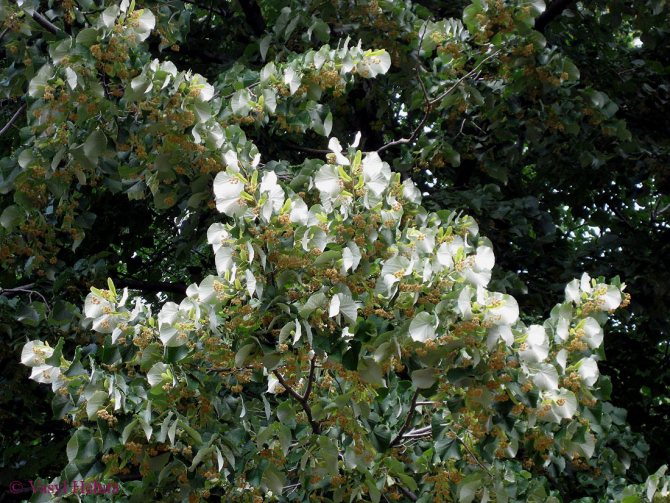

Manchurian linden
Manchurian linden is a tree up to 20 meters high. The crown is of the correct shape, rounded. Representatives of this species are similar to specimens of Amur linden, but differ in larger leaves and flowers. The flowering is beautiful, abundant.
Small-leaved (heart-shaped)


Small-leaved linden
Small-leaved or heart-shaped linden (tilia cordata) is a tree up to 30 meters high and up to 15 meters wide. The small-leaved linden has synonymous names: lutoshka, scrubber, lubnyak. The crown of the tree is initially conical, later ovoid. The main branches grow diagonally or vertically, the side shoots bend and hang down at the bottom of the crown.
The heart-shaped linden has green glossy, dark gray leaves with a serrate edge on the back. In autumn, the heart-leaved linden delights the eye with beautiful light lemon leaves. Young branches of representatives of the species are covered with satin bark, old ones - with deeply cracking bark of a smoky gray color. The flowers are fragrant, with bracts, light straw color, collected in semi-umbrellas. The fruit is a nut with one seed. Blooms in July; fruits ripen in October. One of the common varieties of this species, bred specifically for urban landscaping, is the small-leaved lime tree Greenspyer.
An advantageous feature of the Greenspair variety is that the representatives of the variety grow in height two times less than the species small-leaved linden. They have a more compact and dense crown, better tolerate low air and soil moisture.
Ordinary


Common linden
Common linden is a graceful tree up to 40 meters high, a natural hybrid of small-leaved linden and large-leaved linden. The crown of the tree is wide, shaped like a pyramid. The flowering time begins in July.
Siberian


Siberian linden
Siberian linden is a tree up to 25 meters high. The bark of old trunks is dark and cracked. Young shoots are dark purple or brown-amber, glabrous, with small rounded lenticels. The tree blooms in the second half of July, flowering duration is two weeks. Linden honey is light, almost white, with a delicate aroma of linden flowers, of excellent quality. Belongs to the best varieties. Differs from others in late flowering and high winter hardiness.
Japanese


Japanese linden
Japanese linden is a tree up to 20 meters high. Grows in East Asia, in deciduous subtropical forests. Young bark is smooth, brown, old with grooves, dark. The crown is high, compact, oval in shape. Leaves are small, 5-7 cm, oval, olive on the outside, gray on the inside, with hairs in the vein corners. Flowering occurs in July or August for 14 days. The flowers are tiny, in large numbers collected in drooping inflorescences.Fruits, ripening by September, are round, even, nuts covered with fluff. Representatives of this species grow rather slowly. The species is frost-resistant, it is an exclusively melliferous plant. Japanese linden tea has proven itself as a flavored green tea.
Care
Linden lives longer if you follow some rules for caring for it. Trees can suffer from drought, so regular and correct watering is very important in hot dry summers.
After planting the seedlings of the plant and during the first two years of their development and growth, it is necessary to apply nitrogen fertilizers to the soil.
The crop can withstand shade, so it can be planted in secluded areas of the garden.
Trees grow well on fertile, well-drained soils, do not tolerate soils with accumulated harmful salts, thrive better on lands with lime (from neutral to alkaline). The root system of the plant is sensitive to compaction.
Trees withstand frost, quickly adapt to changing climatic conditions. Trees are cut a year after planting, in the spring, shortening by 1/3 to form side shoots, and in the fall the overgrown linden is trimmed. The culture reaches full development only by the age of 20-40.
Chemical composition
The flowers of this tree contain essential oil. It includes:
- glycosides;
- farnesol;
- thiliacin;
- saponins;
- vitamin C (31.6%);
- flavonoid glycosides (kaempferol and quercetin);
- carotene;
- tannins.
Linden leaves are rich in vitamin C, protein and carotene. The fruits contain more than 60% fatty oils, which are close in quality to Provencal, and taste like almond or peach. The bark contains tiliadin, a triterpene substance, as well as oil.
Diseases and pests
The plant is quite resistant to diseases and pests. Adverse growing conditions can provoke diseases. Diseases most often affecting the tree: perforated and black spot (control methods: burning fallen fruits and leaves as sources of infection, processing shoots with 1% Bordeaux liquid), white rot (copper-containing preparations are used to combat).
Pests that can harm a tree: bedbugs, scale insects, silkworms, gall mites, bark beetles, pipe beetle and others. To combat these pests, young plants are sprayed with insecticides. In addition to insects, birds and rodents can harm crops.
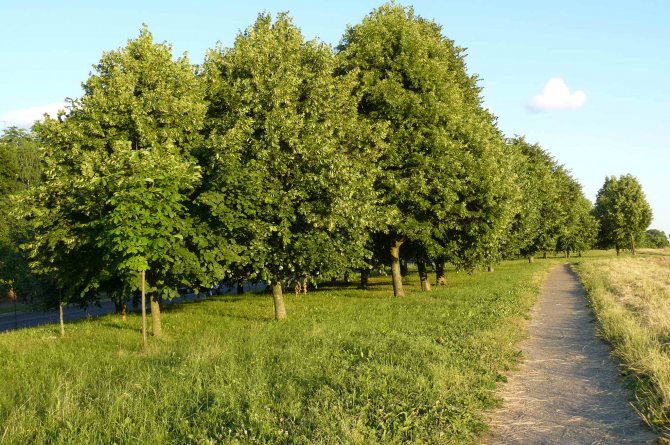

Leaves
Long-petiolate, alternate, cordate, rather large leaves of cordate linden. Their plates are ten centimeters long and are dark green in color. From above, they are serrate, with a pointed tip, as a rule, symmetrical, much less often they are unequal. Their width is almost equal to their length.
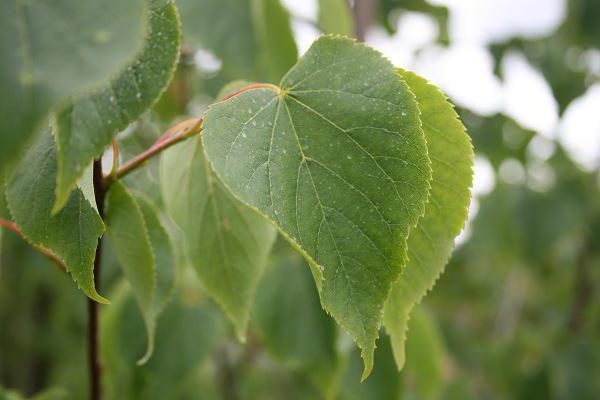

The underside of the leaves is bluish-green, with bunches of yellowish-brown villi located in the nodes of the veins. Heart-shaped linden leaves bloom in May-June.
Planting linden
The tree propagates both by seeds and vegetatively (by layering, shoots, cuttings, grafting). For planting linden in hedges on the site, it is better to propagate it by layering.
Trees are planted in hedges in a line, wavy, checkerboard pattern. Saplings and crop seeds can be purchased at garden centers or ordered online.
From seedlings
Before planting, a decision should be made about the final location, height and shape of the tree crown. Too dense planting of plants inhibits their development, leads to the creation of an unfavorable microclimate with stagnant air, reduces the penetration of sunlight, and makes trees susceptible to the effects of diseases and pests. If you put the plant in water for a couple of hours before planting, it will better tolerate the lack of water during planting and the further growth process.
Before planting a seedling, the soil must be prepared in advance, fertilizing and hilling. It is necessary to check if the soil is too moist, if it is not frozen.Linden is quite patient with minor damage to the root system, but, nevertheless, planting is done carefully.
First of all, for seedlings, a planting hole is dug with a depth of at least 50 cm.When digging a planting hole, the volume of the root system is taken into account so that it is freely placed in the hole, and the lateral root branches do not break and are not pinched. It is recommended to remove the top fertile soil layer, set it aside separately from the bulk of the earth, so that at the end of the burying of the planting hole, lay it in its original place. The bottom of the planting pit should be well loosened with a shovel or pitchfork, then a layer of drainage is laid. It can be pebbles, rubble or broken brick.
Add compost, which is mixed with drill meal with superphosphate. In no case should fresh manure be introduced. Compost plays a significant role in the exchange of nutrients in the garden and is one of the best and cheapest sources of humus.
The compost is not suitable for non-rotting waste: various types of artificial materials, rubber, metal objects or glass.
Suitable for compost: shredded stems of herbs, cut branches of trees, bushes, bark. Use kitchen waste: peels and trimmings of vegetables, fruits, coffee grounds, crushed eggshells. Over time, the soil is depleted and, if additional organic or inorganic fertilizers are not applied, the fertility of the soil will be greatly reduced.
In the process of planting plants, sometimes you have to deal with a situation where the roots are firmly attached to the surrounding clod of earth. In such a situation, it is necessary to remove the dead or damaged parts of the roots, smoothly cutting them off from the main root system, shorten only those segments and branches that are too long and do not fit in the prepared hole. Before planting a lump on the roots of seedlings, it is necessary to water well. After that, a seedling is lowered into the pit, covered with a soil mixture: turf soil, humus, sand. The root collar of the seedling is placed at the level of the soil, it can be slightly lower. After planting, an irrigation circle is formed around the seedling with a 5 cm high embankment. A bowl-shaped hole around the seedling is covered with rotted manure or covered with a mulching layer. This will protect the soil from excessive drying out and provide the seedlings with nutrients. After planting, the plants are watered abundantly. After the earth has settled, it is recommended to strengthen the tree with a supporting wooden stake.
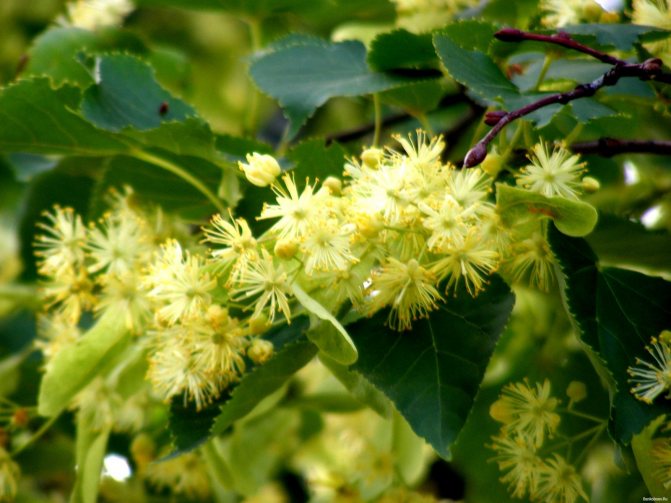

Interesting information
The linden tree was considered sacred by the ancient Slavs. He was associated with the goddess of love - Lada, who personified happiness, beauty and grace.
Linden has a soft yet strong energy. It absorbs negative energy, relieves depression and depression, restores vitality. Contact with a tree creates a feeling of peace, warmth, inner harmony.
Linden was a favorite plant in country estates. Today, in different parts of Russia, on the site of ancient parks, there are centuries-old lime trees. For example, in the village of Mikhailovskoye, a whole linden alley has been preserved, where A. Kern loved to walk. The linden alley in Yasnaya Polyana, associated with the name of Leo Tolstoy, has also survived.
Wood
The massif is represented by an equally dense sapwood of a pale yellow or pinkish color. The texture is weak, the natural pattern is a bit like birch. The gloss of the surface is soft, slightly matte.
The quality characteristics of linden wood are slightly lower than those of pine or oak; the total drying coefficient is 0.58. During the preliminary drying process, the wood almost does not warp and does not crack due to the uniform saturation with moisture. The density of dry sawn timber is about 450 kg / m³. Linden has low strength and resistance to mechanical stress, similar to aspen wood. It is prone to swelling, does not hold nails and staples well, and is prone to rotting and fungal attack.
The advantages of linden are plasticity and ease of processing: the material bends well, is cut, sawn, impregnated with coloring agents and stains, glued and polished.
Linden has long been used to build barns, made hives, chests, chests, barrels for pickling cabbage, vats for winemaking, made kitchen utensils: scoops, ladles, spoons, pots. Bast was especially appreciated: bast shoes were woven from young bast, matting was knitted.
Today linden is used in furniture and turning production, toys, pencils, blanks for decoration are made from it. Linden lining is used for sheathed saunas and baths, shelves are made of boards. Due to its low thermal conductivity, this wood reduces the likelihood of burns when touched in a hot room.
Use in cosmetology
If you want to refresh your tired face, try a compress. To do this, you need to brew linden flower tea and add two mint leaves to it. Strain the resulting composition and heat a little. Pour hot tea into a large bowl. Place a cup of cold water next to it, and prepare two soft cotton napkins in advance.
First, moisten one of the napkins in hot tea, squeeze it, put it on your face and hold for no more than two minutes, then do the same with the second napkin, which must be soaked in cold water. Change the compresses two or three times, but the last one should be cold, which must be kept on the face for at least five minutes.
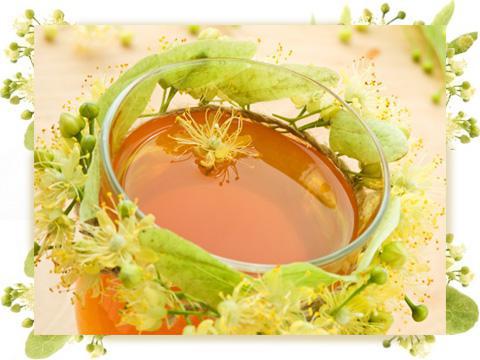

Healer tree
The linden tree, the photo and description of which clearly confirms its value for humans, has healing properties. It has long been a rescue tree, helping a person to get rid of many diseases; moreover, all its parts perform the therapeutic function: bark, branches, flowers, leaves. Traditional medicine has been using the healing powers of the linden tree for a long time.


Linden coal, obtained from branches and wood, was used by the Slavs for the treatment of diseases of the gastrointestinal tract, diarrhea, dysentery and for healing wounds. A boiled mass of lime bark was used to treat burns, and a decoction of fresh leaves and buds was used as an analgesic and anti-inflammatory agent. Infused linden flowers are still considered an excellent diaphoretic and are used for colds, fainting and for rinsing the mouth with inflammation of the throat and gums. Linden nuts were used to stop internal bleeding, and powder from crushed dry leaves of the tree was used to stop bleeding from the nose.
Linden tea, characterized by a sweetish taste and pleasant aroma, treats colds. Also, such a drink has a diuretic effect, cures cystitis, urolithiasis, pyelonephritis, hypertension. Contraindications include an additional load on the heart, therefore, when drinking linden tea, you should always remember that this is just a medicinal drink that should not be used as a substitute for regular tea. Linden flowers are used for lotions and compresses; in case of excessive emotionality and nervous disorders, baths on linden decoctions are recommended, a feature of which is a beneficial effect on the body as a whole.
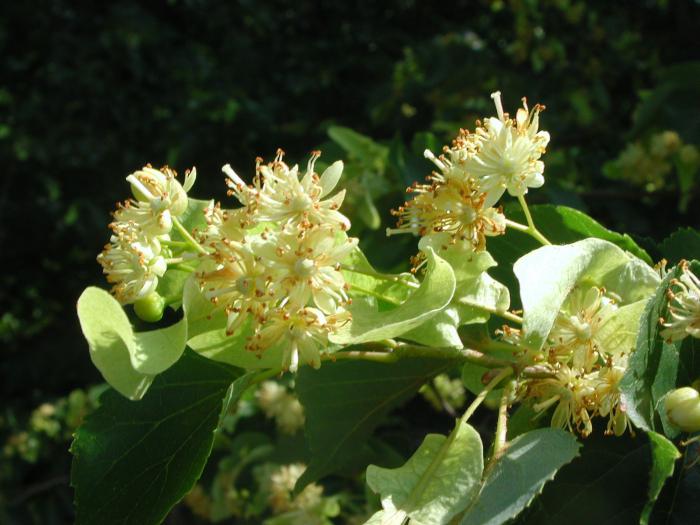

Linden infusion helps to reduce the oily skin of the face with its regular use.
Reproduction by layering
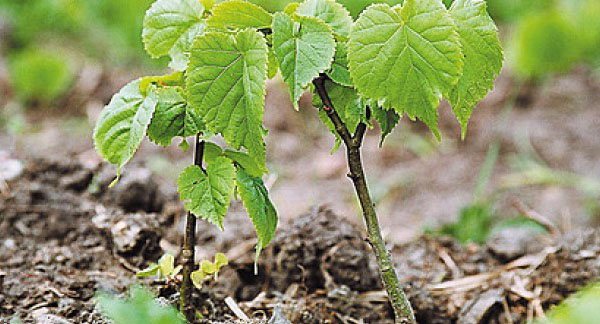

To obtain a stem cut in the spring, before the foliage appears, the lower branches should be bent to the ground, laid in shallow grooves and dug in. In approximately the same way, cuttings of currants and gooseberries are obtained. After 1–2 years, the branches will sprout, and a new plant will appear above the ground. It is chopped off from the maternal root with a sharp shovel and transplanted to a permanent place.
Reproduction of linden by root layers is even easier. Mature plants produce abundant growth, which is carefully removed from the parent tree and transplanted to a new location.
Linden is recommended to grow in areas near apiaries, as it is an excellent honey plant. Thanks to it, the productivity of bees and the quality of honey increase significantly.
Application in traditional medicine
Linden-based preparations are used internally for:
- nervous excitability;
- colds;
- convulsions;
- chronic cough (including smokers);
- accumulation of sputum;
- some diseases of the liver, kidneys;
- hypertension;
- as an aid for acute bronchitis and flu;
- insomnia.
External use is also recommended for inflammatory skin diseases (for washing).
Tea made from dried or fresh linden flowers has a diaphoretic, expectorant, antispasmodic, hypotensive, laxative effect. It is recommended in the treatment (as an adjuvant) for indigestion, atherosclerosis, hypertension, nervous vomiting, hysteria and palpitations.
Distribution [edit | edit code]
Representatives of the genus are common in the temperate and subtropical zones of the northern hemisphere. A particularly wide variety of linden species is confined to Southeast Asia. For example, there are 15 endemic species in China alone. In the temperate zone of Europe, Asia and North America, linden is less represented. It grows best in warm and fairly humid regions, such as western Transcaucasia, the south of the Far East - Primorye; in North Asia, as a relic of the Tertiary, preglacial age, it is found in continental regions remote from the oceans - the south of Western Siberia and the Krasnoyarsk Territory. The natural range is the entire temperate zone up to 60-66 ° N. (the northernmost natural places of linden in the world - in Norway - at 66 ° N) [6] [7]. It is widely used in landscaping cities and villages.
Content with very diverse soils, but prefers rich. Easily propagated by seeds and vegetatively.

